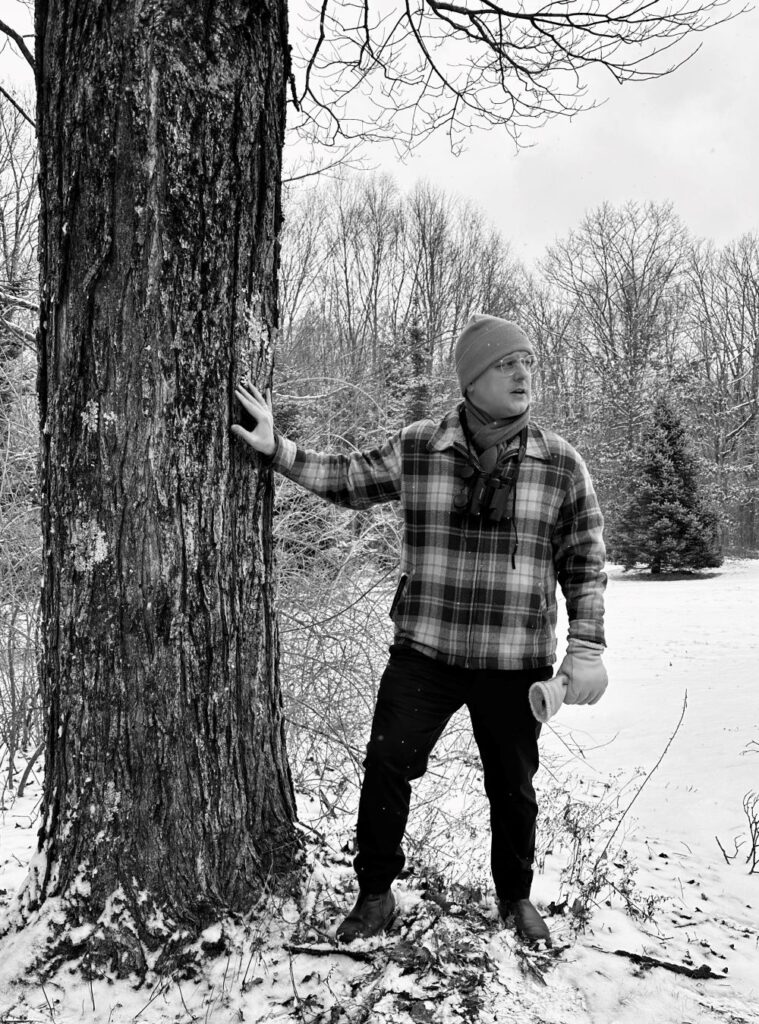It’s Only Natural
Identifying Trees in Winter Can Be a Challenge
By Jude Mead

Great Mountain Forest Executive Director Dr. Michael (Mike) Zarfos explains how to identify the maple tree in winter by confirming the opposite branching and examining the bark.
Identifying trees in winter can be a challenge, especially in places where snow covers the ground and deciduous trees stand bare. According to Dr. Mike Zarfos, the executive director of Great Mountain Forest (GMF), most people rely on looking at the leaves during the spring, summer, and fall seasons to tell the tree type, but in winter it becomes necessary to rely on other features such as bark, buds, twigs, and the overall tree structure. During a recent presentation where participants were invited to explore the many trees at GMF, Zarfos explained to the large group of attendees how to identify trees during the winter season in this distinctive region.
“Does anyone know what this tree is? Don’t tell us, though, if you do.” he asked as his hand rested on its bark. A few shook their heads yes. “Most people,” he said, “scan the ground for what we call forensic evidence such as leaves or seeds, but as you can see, the snow has covered them. Then we look at the twigs and bark.” Zarfos held up a small twig and pointed out the arrangement of the branches. “Notice that the branches grow directly opposite one another. That is a distinctive sign of the maple, ash, and dogwood. One way to remember the trees that have this feature is the acronym MAD. Others have alternate branching such as the oak,” he said.
To identify this tree, Zarfos must investigate deeper, so he examined the bark. “The bark of a tree,” he pointed out, “is one of the most reliable features for identification during winter. Each species has its own unique bark characteristics such as color, texture, and pattern. Observe the distinctive grayish-brown, warty looking bark. It evolves into broad plates that peel off the stem at their sides as the tree grows larger. These characteristics let me know this is a sugar maple rather than, for example, a red maple, which has smooth bark when young, and shaggy bark that peels from the tops and bottoms of each strip when old.” Zarfos added that the texture and patterns of the bark on other trees also provide additional clues, especially in winter. “For example,” he said, “there is the smooth bark of the beech, the deeply furrowed black locust, and the interlocking ridges of the hickory.”
Noticing the tree shape and structure is also useful. Zarfos pointed out that the overall growth habit or what the tree looks like from a distance can help narrow down possibilities. “Look to see whether the tree has a broad, spreading crown such as the sugar maple, a sparse twiggy crown like the white ash or a vaselike shape as with the elm. Evergreens, spruces and firs are often conical, while hemlocks and white pines tend to be messier at their tops. When you look at a hill in profile, it’s generally the white pines that pop out above a canopy of hardwoods,” he explained.
Zarfos included other ways to recognize tree types. Certain trees, he said, retain features that persist through the winter, such as seeds, fruits, and leaves. The American beech for example retains its smooth, gray bark and often keeps its papery, tan/copper leaves throughout winter. Oaks have brown, dried leaves on lower branches and their acorns can sometimes be found nearby, and the bark of birch trees has slightly different color and degree of peelings between species. According to Zarfos, the tree’s growing environment can give hints as well. “Willows, red maple, and silver maple thrive in wetlands and moist soil. Oaks, hickories and pitch pine prefer dry, nutrient-poor soils. In shaded, moist, but well drained, forests you’ll find sugar maples and American beech.”
Identifying trees in winter requires a blend of careful observation and practice. It also helps to use a field guide. Zarfos recommends “Bark: A Field Guide to Trees of the Northeast” by Michael Woitech and Tom Wessels.
Zarfos hopes to continue offering these kinds of short and long workshops through Great Mountain Forest’s Woodland Academy for the community. He emphasized that folks should reach out if they are interested in learning about a particular subject. “Options,” he said, “could include tree ID, fern ID, herb ID, edible and medicinal plants, tracking, maple sugaring, managing for timber, managing for climate change, managing for recreation and similar programs about how to care for and use a forest.”
